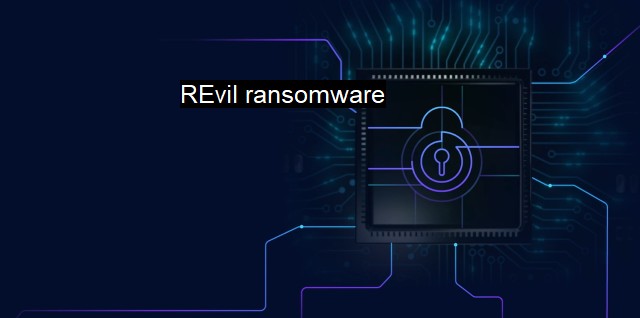What is REvil ransomware?
REvil Ransomware: Understanding Its Potency and Impact on Businesses and Governments - A Comprehensive Analysis
REvil ransomware, also known as Sodin or Sodinokibi, is a destructive malware belonging to the category of ransomware. REvil ransomware is perceived as a potent threat in view of its devious and devastating operations, disrupting the online safety, potential, and disposition of many businesses across the globe.Ransomware like REvil communicates its despicable design by encrypting the victim's data and demanding a huge amount in ransom for the decryption key. What distinguishes REvil from ordinary ransomware is its exceptionally aggressive and menacing nature conspiring with its sophisticated operations.
Involved in a series of cyber-attacks worldwide, this commonplace yet remarkably treacherous ransomware has been evaluated as one of the distinct challenges in cybersecurity. With more than $100 million claimed to have been generated as extortion money, it stands as an archetype of ransomware-as-a-service – a business model in which access to ransomware encryption tools is sold.
Reminiscent on its offensive tactics, REvil ransomware evolved its operations over time. Initially, it concentrated on encrypting victims' files, then progressively shifted towards implementing tactics like stealing proprietary data before encryption, and threatening to make stolen data public unless the demanded ransom was met. This double-extortion tactic has boosted its potency, making containment a daunting task even for robust cybersecurity units across organizations worldwide.
The core feature of the REvil, as befitting its ransomware nature, lies in its encryption approach. Exploiting the well-established RSA encryption method, REvil successfully manipulates victims' files for encryption and ensures that its related decryption keys remain safely in the possession of the perpetrators. This embedding of powerful encryption techniques amplifies both the operational efficiency and destructive potential of REvil, limiting the effectiveness of conventional ransomware protocols.
Technical sophistication and elusive processes allow REvil to penetrate systems smoothly, posing challenges for antivirus detection. Its infection pathway varies across a wide range of methods such as exploiting weak Remote Desktop Protocol credentials, software vulnerabilities, spear-phishing techniques, and more. Post infiltration, it executes the process thread, modifies sensitive configuration resources, and deactivates various antivirus & security software services, thereby spearheading an extensive disabling of the infected device's security system.
Frequently the subject of discussions within the cybersecurity community, efforts to annihilate the impacts of REvil have been consistent yet taxing. Antivirus software providers have been striving to contain the escalating threat by means of heuristics, behavior-based detection, and offline scanning mechanism, along with the redesigning of predefined signature databases, hinting at the need for constant agility and adaptability within the defense mechanism landscaping against sophisticated threats like the REvil.
It is crucial to note that the evolution of threats like REvil underlines the necessity of robust backup strategies. It emphasizes the significance of upgrading and updating the software regularly, enhancing the security of Remote Desktop Protocol credentials, and advocating the culture of safety awareness among organizational personnel, to guard against the catastrophic impacts of ransomware cyber attacks.
REvil's growing supremacy in the cybercrime landscape marks it out as a concrete threat that must be forestalled and minimized to safeguard the cyber environments from sophisticated perils. Understanding these threats forms the basis for any proactive cybersecurity strategy, strengthening resilient architectures and ensuring the security of personal and commercial interests in an increasingly interconnected digital environment.
Hence, countering REvil and other variants of ransomware demands an interdisciplinary approach, coupled with advanced encryption capabilities of antivirus software, improved cybersecurity infrastructure, and enlightened cyber hygiene practices.

REvil ransomware FAQs
What is Revil ransomware?
Revil ransomware is a type of malware that encrypts files on an infected computer or network and demands payment in exchange for the decryption key. It is a particularly dangerous form of ransomware that targets businesses and organizations.How does Revil ransomware infect a system?
Revil ransomware can infect a system through various methods, including phishing emails, drive-by downloads, and malicious attachments. Once the malware is on the system, it can spread quickly through the network and encrypt files on multiple machines at once.What can be done to protect against Revil ransomware?
To protect against Revil ransomware, it is important to keep antivirus software up-to-date and to regularly back up important files. It is also important to educate employees on how to recognize and avoid phishing emails and other common malware vectors. A robust cybersecurity strategy that includes multiple layers of protection is also recommended.What should be done if a system is infected with Revil ransomware?
If a system is infected with Revil ransomware, the first step is to isolate the infected machine or machines from the rest of the network to prevent further spread. It is important not to pay the ransom, as this does not guarantee that the files will be decrypted and can encourage future attacks. Instead, it is recommended to seek assistance from a reputable cybersecurity professional or incident response team to assist in removing the malware and restoring data from backups.| | A | | | B | | | C | | | D | | | E | | | F | | | G | | | H | | | I | | | J | | | K | | | L | | | M | |
| | N | | | O | | | P | | | Q | | | R | | | S | | | T | | | U | | | V | | | W | | | X | | | Y | | | Z | |
| | 1 | | | 2 | | | 3 | | | 4 | | | 7 | | | 8 | | |||||||